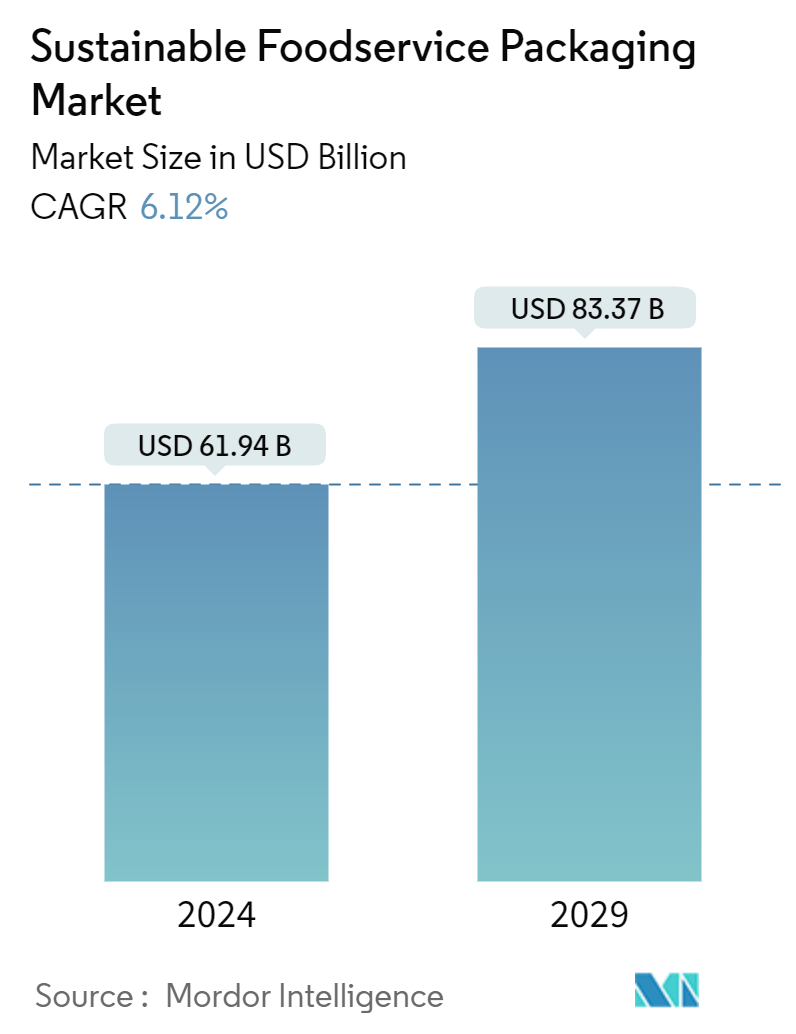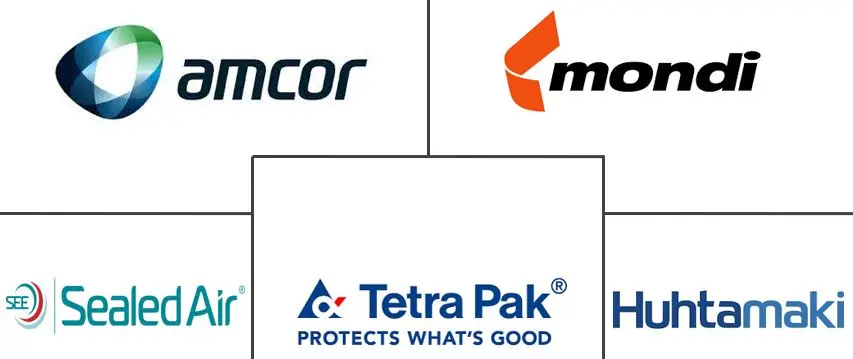Market Size of Sustainable Foodservice Packaging Industry

| Study Period | 2019 - 2029 |
| Market Size (2024) | USD 61.94 Billion |
| Market Size (2029) | USD 83.37 Billion |
| CAGR (2024 - 2029) | 6.12 % |
| Fastest Growing Market | Asia Pacific |
| Largest Market | North America |
Major Players
*Disclaimer: Major Players sorted in no particular order |
Sustainable Foodservice Packaging Market Analysis
The Sustainable Foodservice Packaging Market size is estimated at USD 61.94 billion in 2024, and is expected to reach USD 83.37 billion by 2029, growing at a CAGR of 6.12% during the forecast period (2024-2029).
- With a rising customer focus on environmental concerns and the repercussions of package leaks, sustainability in packaging emerges as a pivotal trend shaping the industry. Consequently, stringent sustainability mandates are emerging across various sectors. The foodservice industry, alarmed by the environmental impact of plastic containers, is pivoting toward recycled materials, propelling the market studied. Companies are increasingly adopting recycled and biodegradable materials to meet these new standards, which not only help in reducing the carbon footprint but also cater to the eco-conscious consumer base.
- The surge in urban population growth is fueling the demand for prepared and ready-to-eat foods, consequently bolstering the need for sustainable packaging solutions in the foodservice sector. This, in turn, is set to drive the market in the coming years. Urbanization leads to a higher concentration of people in cities, which increases the demand for convenient food options. This trend is particularly evident in metropolitan areas where busy lifestyles necessitate quick and easy meal solutions, thereby increasing the reliance on foodservice packaging.
- Across major regions, urbanization, evolving lifestyles, the rush of modern work life, and a growing reliance on online food platforms are reshaping the food service and landscape. This shift is amplifying the call for sustainable packaging solutions in the sector. The convenience of online food delivery services has led to a surge in single-use packaging, prompting a need for more sustainable alternatives. Companies are responding by developing innovative packaging that is not only eco-friendly but also maintains the quality and safety of food during transit.
- As the industry steers toward a waste-free future, challenges like packaging innovation, encompassing novel materials, refill systems, and recycling solutions, come to the forefront. Nestlé, bolstering commitment, conducts extensive in-house research via the Nestlé Institute of Packaging Sciences, earmarking a CHF 250 million sustainable packaging venture fund to back startups focusing on these pivotal areas. This fund aims to accelerate the development and adoption of cutting-edge sustainable packaging technologies, ensuring that new solutions are both effective and scalable.
- While the benefits of sustainable packaging are evident, it is crucial to note that its costs are notably higher than traditional foodservice alternatives. This cost disparity is attributed to the sourcing of materials, both virgin and recycled, and the industry's nascent supply chains and manufacturing processes, all of which currently lack economies of scale, thus impeding market growth. The higher costs are also due to the advanced technology and research required to develop sustainable packaging solutions that meet industry standards and consumer expectations.
Sustainable Foodservice Packaging Industry Segmentation
The study aims to analyze and understand the packaging automation market's current growth, opportunities, and challenges. The scope of market analysis is segmented by product type (corrugated boxes and cartons, trays, plates, food containers and bowls, clamshells, and other product types), end user (quick-service restaurants, full-service restaurants, institutional, hospitality, and other end users), and geography (North America, Europe, Asia-Pacific, Latin America, and Middle East and Africa). The market sizes and forecasts are provided in terms of value in (USD) for all the above segments.
| By Product Type | |
| Corrugated Boxes and Cartons | |
| Trays, Plates, Food Containers, and Bowls | |
| Clamshells | |
| Other Product Types |
| By End Users | |
| Quick Service Restaurants | |
| Full Service Restaurants | |
| Institutional | |
| Hospitality | |
| Other End Users |
| By Geography | ||||||
| ||||||
| ||||||
| ||||||
| Latin America | ||||||
| Middle East & Africa |
Sustainable Foodservice Packaging Market Size Summary
The Sustainable Foodservice Packaging Market is experiencing significant growth, driven by increasing consumer awareness and demand for environmentally friendly packaging solutions. As concerns about environmental impacts and plastic pollution rise, the foodservice industry is shifting towards sustainable packaging options. This trend is further fueled by urbanization and lifestyle changes, which have led to a higher demand for prepared and ready-to-eat food products. The market is characterized by innovations in packaging materials and systems, as companies strive to meet the growing sustainability requirements. Despite the higher costs associated with sustainable packaging, the market is attracting new players due to its potential for growth and the increasing willingness of consumers to pay a premium for eco-friendly options.
The market landscape is highly competitive, with numerous players such as Amcor Limited, Sealed Air Corporation, and Mondi Plc leading the charge in sustainable packaging solutions. Partnerships and collaborations are becoming more common as companies seek to enhance their sustainability efforts and expand their market reach. The COVID-19 pandemic has also played a role in accelerating the demand for secure and resealable packaging, highlighting the importance of food safety. Regions like Asia Pacific are witnessing rapid adoption of sustainable packaging, driven by densely populated countries like China and India. As the market continues to evolve, companies are investing in new technologies and processes to improve the efficiency and scalability of sustainable packaging solutions, aiming to reduce their environmental footprint and meet the demands of a growing consumer base.
Sustainable Foodservice Packaging Market Size - Table of Contents
-
1. MARKET INSIGHTS
-
1.1 Market Overview
-
1.2 Industry Value Chain Analysis
-
1.3 Industry Attractiveness - Porter's Five Forces Analysis
-
1.3.1 Bargaining Power of Suppliers
-
1.3.2 Bargaining Power of Buyers
-
1.3.3 Threat of New Entrants
-
1.3.4 Degree of Competition
-
1.3.5 Threat of Substitutes
-
-
1.4 Industry Ecosystem Analysis
-
1.5 Assessment of the Impact of Microeconomic Factors on the Industry
-
-
2. MARKET SEGMENTATION
-
2.1 By Product Type
-
2.1.1 Corrugated Boxes and Cartons
-
2.1.2 Trays, Plates, Food Containers, and Bowls
-
2.1.3 Clamshells
-
2.1.4 Other Product Types
-
-
2.2 By End Users
-
2.2.1 Quick Service Restaurants
-
2.2.2 Full Service Restaurants
-
2.2.3 Institutional
-
2.2.4 Hospitality
-
2.2.5 Other End Users
-
-
2.3 By Geography
-
2.3.1 North America
-
2.3.1.1 United States
-
2.3.1.2 Canada
-
-
2.3.2 Europe
-
2.3.2.1 United Kingdom
-
2.3.2.2 Germany
-
2.3.2.3 Rest of Europe
-
-
2.3.3 Asia-Pacific
-
2.3.3.1 China
-
2.3.3.2 Japan
-
2.3.3.3 India
-
2.3.3.4 Rest of Asia-Pacific
-
-
2.3.4 Latin America
-
2.3.5 Middle East & Africa
-
2.3.6
-
-
Sustainable Foodservice Packaging Market Size FAQs
How big is the Sustainable Foodservice Packaging Market?
The Sustainable Foodservice Packaging Market size is expected to reach USD 61.94 billion in 2024 and grow at a CAGR of 6.12% to reach USD 83.37 billion by 2029.
What is the current Sustainable Foodservice Packaging Market size?
In 2024, the Sustainable Foodservice Packaging Market size is expected to reach USD 61.94 billion.

